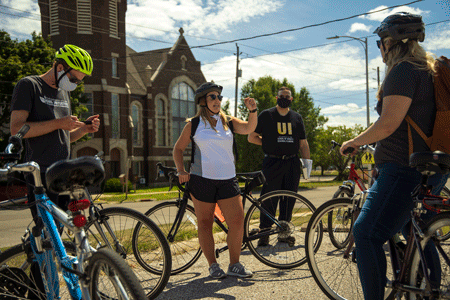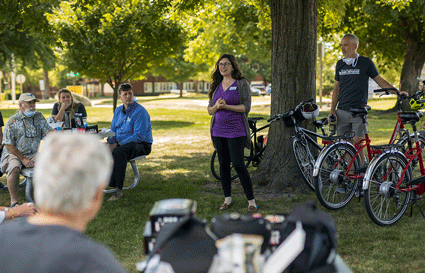Many graduate programs offer experiential learning opportunities for students with local organizations. Students within the University of Iowa’s School of Planning and Public Affairs have the unique chance to work as an interdisciplinary team through comprehensive partnerships with local communities.
The Iowa Initiative for Sustainable Communities (IISC) is an engaged-learning program working with communities to address challenges related to sustainability. Students and faculty focus on issues of economic, environmental, and social sustainability through the projects they pursue. This year, IISC leadership chose the cities of Waterloo and Manchester to advance shared goals.

Waterloo stood out as a potential partner for the variety and quality of projects for students to pursue. The program was also impressed by the local leadership and their willingness to be open to new ideas. Waterloo has already seen more than 250 million dollars’ worth of economic development take place downtown and millions more in private investment are currently underway, but leadership saw the need for additional improvement.
“After leaving to go to the University of Iowa about five years ago, it seems like every time I come back there are big things happening in Waterloo,” says Rachael Schaefer, a Waterloo native participating in the partnership as a graduate student. “It is really exciting to see the downtown revitalized and the community coming together. That’s never really changed since I’ve lived here. There are always people working together and helping to make this a great place to live—better than it already is.”
Students and faculty are looking to build on this momentum with a variety of projects across the city, including the Church Row Neighborhood Plan. Church Row, a core neighborhood near downtown that is known for its historic line of churches, was selected for assistance with housing issues and to combat several environmental concerns. The high proportion of rentals, absentee landlords, and dilapidated housing in the neighborhood negatively affect people’s view of the area.
Church Row has plenty of strengths, however, such as an engaged neighborhood association and a diverse resident population. IISC partners expect these characteristics to spur on support for student projects. For one student working on the plan, connecting with locals in the neighborhood starts with simply walking out his front door.
“I definitely feel at home in the neighborhood,” says Leon Begay, a graduate student in the planning program who moved into the Church Row neighborhood several years ago. “Given that I’m from a reservation in the Southwest where many people looked like me and spoke like me, coming to the Midwest was very different. The ethnic makeup of Church Row is a lot of refugees and people of color like me, though, so I felt a bit more comfortable moving there. That was a very good way for me to start a new life here in the Midwest.”
Those involved with the Church Row project would like to maintain the diversity and historic character of the neighborhood, while focusing on housing improvements and other aspects of the plan. Additionally, the plan encompasses commercial and economic development and an effort to foster social cohesion, social capital, and civic engagement within the neighborhood. Engaging community members in the planning process undoubtedly helps further these goals.
“Maintaining safe and affordable housing is a key component of this plan,” says Travis Kraus, Director of IISC and an Associate Professor in the School of Planning & Public Affairs. “However, we also need to encourage civic pride and bring people who really care about the Church Row neighborhood into the conversation. They are the ones who are leading the charge on making change, so the plan is built around a vision that the residents of the neighborhood care about and want to see happen.”
On their first visit to the city, students were able to meet with local residents, gather at a neighborhood park, and take a socially-distanced bike tour of the area. While engagement efforts will look different this year because of the pandemic, students and residents are committed to this new civic plan. The initial meeting offered fresh ideas on how to engage community members and new perspectives on what a partnership could look like.
“This specific opportunity has given me the chance to get the most out of my planning program,” says Begay. “I’m working on a capstone project within the neighborhood and community I live in, which has been especially helpful in introducing me to a lot of the people who are driving change here. That community energy was not that visible to me before this, so it’s very exciting to know all these different dreams and ideas are possible.”

Local residents like Begay will play a crucial role in implementing the proposal and addressing key challenges. After the partnership to improve housing and civic engagement ends, community members may also look to the Church Row project and residents involved as models for future community improvement efforts.
“Not only will this plan raise the value of all those things in the Church Row neighborhood, it will help us create sustainable models that we may be able to use for community transformation in other parts of the city, as well,” says Waterloo Mayor Quentin Hart. “It is great to work with this neighborhood, but there are so many other areas within our community that need an incredible amount of help and support. I see this being a springboard to transforming other parts of our community that need it, as well.”
The Church Row Neighborhood Plan is one of seventeen projects spearheaded by the IISC. More than 100 University of Iowa faculty, staff, and students are working on different initiatives alongside the Church Row project—from law students studying the impact of Waterloo’s “Ban the Box” ordinance to cinema arts students creating mini documentaries on local residents’ inspirational stories. The projects give graduate students hands-on experience to complement their studies, while also bringing extensive resources to the community.
“Working with the University of Iowa for a multitude of different projects in our community is really incredible,” says Hart. “It has given us the opportunity to talk about programs, projects, and other things that we may not have necessarily had the resources to do before. With the planning, programming, and expertise from our partnership, we have the opportunity to focus holistically on our community.”
While leaders have embraced the opportunity to collaborate with students and faculty, the partnership has not been limited to just the city government. Several organizations and individuals from the private sector, as well as nonprofits have jumped at the chance to get involved with the initiatives and to invest in the community. This type of community participation is exactly what students and faculty strive for in these collaborations.
“Our partnership is formally with the City of Waterloo, but we are really working on behalf of all residents,” says Kraus. “We invite people—whether it’s outside organizations that are part of the community fabric there or just residents there—to be involved in the partnership in whatever way they can be. That might mean helping with the funding of projects or just showing up at Zoom meetings for input. We want people to become part of that discussion throughout this next year as we are working there.”
One organization within the community – Habitat for Humanity – has already become an active partner with students working in the Church Row neighborhood. Students began collaborating with the organization for outreach among residents this fall and have since led several neighborhood input meetings with the organization over Zoom. This community input has already been helpful in shaping goals for the neighborhood project underway.
IISC partners with new communities each year, so students are often unsure where they will be conducting their capstone projects. When the opportunity serendipitously comes for them to partner with their hometowns on these projects, it makes the impact of their work that much more meaningful.
“I’m really excited to work in my hometown,” says Schaefer. “I never thought I would have this opportunity from the University of Iowa to work so closely with something I really care about. Being able to go to undergrad and graduate school at Iowa and then have it all come back full circle to the community I was born and raised in has been amazing. I’m really excited to see where that goes from here and how Waterloo is impacted by these projects.”